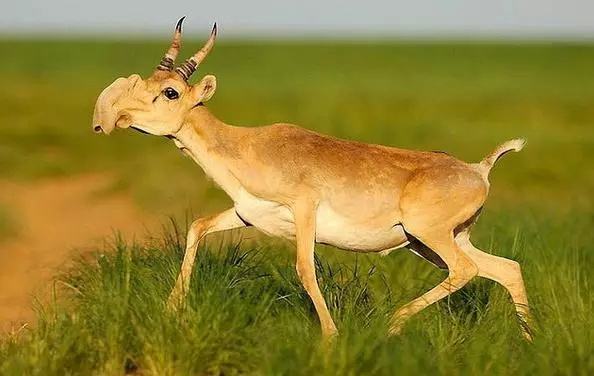Saiga tatarica
IUCN
LCBasic Information
Scientific classification
- name:Saiga tatarica
- Scientific Name:Saiga tatarica,Saiga,Saiga, long-nosed antelope
- Outline:Ungulata
- Family:Artiodactyla Ruminantia Bovidae Caprinae Salicornis
Vital signs
- length:120-170cm
- Weight:36-69kg
- lifetime:About 10 years
Feature
The antelope with the largest nose in the world
Distribution and Habitat
Distributed in Kazakhstan, Mongolia, Russian Federation, Turkmenistan and Uzbekistan.
Regional extinction: China, Moldova, Poland, Ukraine.
Inhabits desert or semi-desert steppe areas. Gathers in large groups every autumn, migrates south to warmer valley steppes, and returns to summer habitats around May of the following year. Active mostly during the day in winter, mainly at dawn and dusk in summer. Has seasonal migration, moves south to sunny warm slopes in winter.
Appearance
The saiga antelope is of medium size, with a body length of 1.2-1.7 meters, a tail length of 7.6-10 centimeters, a shoulder height of 75-80 centimeters, and a weight of 36-69 kilograms. The back is yellow-brown, the buttocks, tail, and abdomen are white, and the summer hair is short and smooth; the winter hair is light, dense and long; the limbs are thin; only males have horns, which are 20.3-25.5 centimeters long, light amber, and have obvious ring edges; the nasal bones are highly developed and curled, and are covered with hair, glands, and mucous ducts; there is a special mucous membrane sac in each nostril, which can heat the inhaled air and make it more humid, and is also related to the sensitive sense of smell.
Only males have horns, which are 28-37 centimeters long, and the base is about 3/4 with ring edges and amber. Because the nose is particularly large and bulging, curved downward, and the nostrils are at the tip, it is named "saiga antelope". The body hair is d
Details
The Saiga antelope has two subspecies. It is named "Saiga" because of its particularly large and bulging nose, which bends downward and has nostrils at the tip.

Saiga antelopes are herd animals that migrate seasonally. Every autumn, they gather in large groups and migrate south to the warmer valley grasslands. In spring, they form groups of 5-6 to 20-30, and then gather into large groups to migrate north to summer pastures. Their migration journey can reach 250-400 kilometers. This animal is quite good at running and can run very fast, up to 100 kilometers per hour. Even a 5-6-day-old baby can run at a speed of 30-35 kilometers per hour. Their sense of smell and vision are very sensitive. They can detect weather changes by smell and see enemies 1 kilometer away by vision.
The saiga is herbivorous, mainly feeding on grass and low shrubs. They feed on a wide range of plants, including many poisonous or saline species. They are extremely thirst-resistant and can go without water for a long time during the grass-feeding season. They only look for water sources in drought conditions when there is a lack of grass.
The saiga antelope is a polygamous antelope with a sex ratio of about 1:4. The estrus period starts in late November. During the estrus period, the male's nose swells and he does not eat. There will be fierce fights between males, and the mortality rate is extremely high. After a 5-month gestation period, April is the peak breeding period, with 1-3 litters, and generally 2 litters per litter. The young antelopes start to eat grass after 1 month, and the females can participate in reproduction at the end of the year (about 8 months old), while the males mature in the following year. The reproductive capacity of saiga antelopes is very strong. About 85% of the young antelopes born that year participate in reproduction, and 96% of the old antelopes participate in reproduction. Under good conditions, the growth rate of saiga antelopes can reach 60%-80%.
The wild population of saiga antelope in China has become extinct. It has been introduced back to China and semi-free-range in Gansu and Xinjiang for experiments and research to restore the wild population. Of the two existing subspecies, the nominate subspecies (S. t. tatarica) was almost extinct at the end of World War I, with less than 1,000 left. By the end of World War II, its population had recovered to 90,000. By 1960, it had risen to more than 1.3 million, but has dropped by more than half in the past decade (Wan Ziming, 1995). The Mongolian subspecies (S. t. mongolica) was originally distributed in northwestern Xinjiang, China. After many surveys, it is believed that it has become extinct in the wild. This subspecies was widely distributed around lakes in western Mongolia in the 1940s and 1950s. By the end of the 1950s, its number had declined, and by 1979 there were only about 200 left (Wan Ziming, 1995). There are also speculations that there may still be a very small number of remnants in the border area between China and the Soviet Union in western Xinjiang.
China issued T.161 wild sheep stamps on May 10, 1991, a set of 4 stamps of 4 types, with a stamp size of 40mm*30mm. Among them, the saiga antelope has a face value of 20 cents and a circulation of 25.973 million stamps.
Listed in the 2012 Red List of Endangered Species of the World Conservation Union (IUCN) ver3.1 - Critically Endangered (CR).
Listed in the first level of the "List of National Key Protected Wildlife in China".
Protect wild animals and stop eating game.
Maintaining ecological balance is everyone's responsibility!








